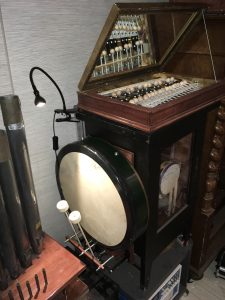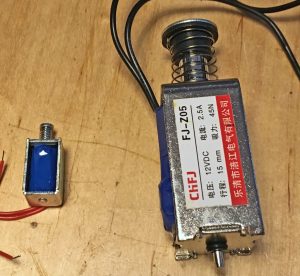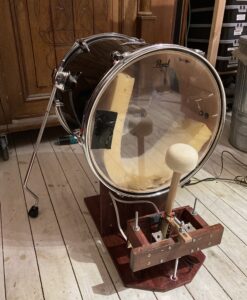Making noise by hitting stuff never grows old. Percussion is also the easiest instrument type to make, so of course we have an ever growing number of unpitched instruments. So far, we only have a few, but there are many more on the way.
Instrument status: Some parts are finished and working, other parts are under construction. Currently working on woodblocks and bass drum
CYMBALS AND TAMBOURINE
Our first unpitched percussion instrument was the tamborine. Later we added two old and very beat up cymbals. These are mounted underneath the EnsembleBot master cabinet and are struck by simple linear solenoids. The solenoids are actuated by MOSFET drivers through the optocoupler array described in the master circuitry page.
Much can be done to improve the pretty lame sound of the cymbals, but that has a low priority right now.
SNARE DRUM
We wanted a snare drum and looked around to find a small and cheap one. But then we tried mounting a shortened drum seiding onto a tiny tambourine drum, and lo and behold! It almost sounds like a snare drum!
We mounted two parallel sticks to be able to do faster drum rolls. That way we don’t have to wait for the stick to finish its movement, and the slight but inevitable asymmetric sound only enhances the organic feel to the drum rolls.
The drum is mounted on a sheet of acrylic glass in fron the tubular bells. This plate is primarily there to attenuate/reduce the volumne of the bells to balance them better with the glockenspiel.
The sticks are pulled by 12V linear solenoids, driven by the same MOSFET driver circuit as the cymbals above.
BASS DRUM (UPDATED)
The first attempt at making some sort of bass drum was using a cheap bodhrán and one or two modified bass drum pedals. The first idea was to use the kind of bi-directional linear actuators used in car locks to pull the mallet pedals. These are very easy to control electrically and apply mechanically, and they are very strong. But they do have a serious flaw: Overheating. A bass drum is expected to be able to beat several times per second over a longer period of time, and that is a bit too much for the internal motor and gearing of a car lock actuator. So, instead we turn to our usual fall-back plan: Solenoids. The linear solenoids we’ve used so far, are not strong enough to pull a bass drum pedal, so we have to take it to the next level.
We use one of these, here compared to one of the solenoids used in our glockenspiel. It’s a 12 V solenoid, with a stroke force of 45 Newton (or appx. 4.5 kg) and a 15 mm stroke length. It looks and feels like it could easily tear apart the entire EnsembleBot. On paper, it should be strong enough to pull the bass drum pedal with sufficient force, and it won’t overheat. However, as it turns out, it does disappoint a bit.
Actually, it doesn’t really work, and the sound of the flimsy mallets on the bodhrán was awful. Time for a redesign.
After watching a youtube video of a MIDI-controlled drumbot, I contacted the creator, who gave me the inspiration for the next design.
First of all, the new bass drum will based on a large floor tom to give a more substantial sound. The previous two flimsy mallets are replaced by a single, heavy bass drum mallet. For activating the mallet with enough force, we use not one but two heavy duty solenoids in parallel.
These two 45 N solenoids are rated for 12V. In this application they will only be actuated very intermittently, e.g. 30 msec with much longer pauses in between, and the risk of overheating the solenoid coils is greatly reduced. So, to give the mallet extra force, the solenoids are driven at 15 V (i.e. a 25 % overvoltage) through a pair of power MOSFET drivers and a dedicated switching PSU block.
This, combined with a much more rigid and lossless mechanical mounting, gives the bass drum its much needed oomph.
The design is quite crude, but it works. The mallet pulley is a bit noisy, which may have to be addressed at some point, but for now, it works quite well.
To drive the power-hungry (2 x 3 A) solenoids, a new driver module had to be built. Based on IRL540 N-channel logic level MOSFETs and an on-board reservoir of 2 x 10,000 uF capacitors to reduce brown-out and overloading the PSU block. It’s basically just an array of 4 simple MOSFET driver stages.
Even though we technically only need two drivers, the module was fitted with four drivers in case we’re going to need more in the future.
The bass drum is quite insular. It has a mains chord for the 15V PSU block, and a B-side ground and a single TTL signal connecting to the percussion circuitry.
IMMEDIATE PLANS
The next percussion instruments will be a 2-sided woodblock, placed next to the snare drum. We have the woodblock and the mallets, and the mechanical design would be rather similar to the snare drum.
Another thing missing for more modern music is a ride cymbal. We have got the two quite dreadful “crash” cymbals sounding like pot lids, but we haven’t got some more simple and delicate cymbal sound.







Hi!
As a one-man operation in the studio, I am simply in need of a device that can hit a drum consistently (basically your snare drum solenoid device) while I set pre-amps, etc.. Preferably, a compact unit that I could move from drum to drum. Is this possible or something you would be interested in building?
Your work is so cool!
Feel free to hit me up via email..!
Thanks for your time!
*mm.
Hi MM
Thank you very much for your kind words. I can’t custom build drum beaters, but you should check out “dadamachines” at https://dadamachines.com/. They offer standardized and configurable units with MIDI interface right out of the box. It’s not cheap, but definately better quality and more versatile, than anything I could build.
Alternatively, if you have access to a 3D printer, this kit could be a solution: https://www.printables.com/model/37788-midi-solenoid-drum-kit
Cheers,
Rune